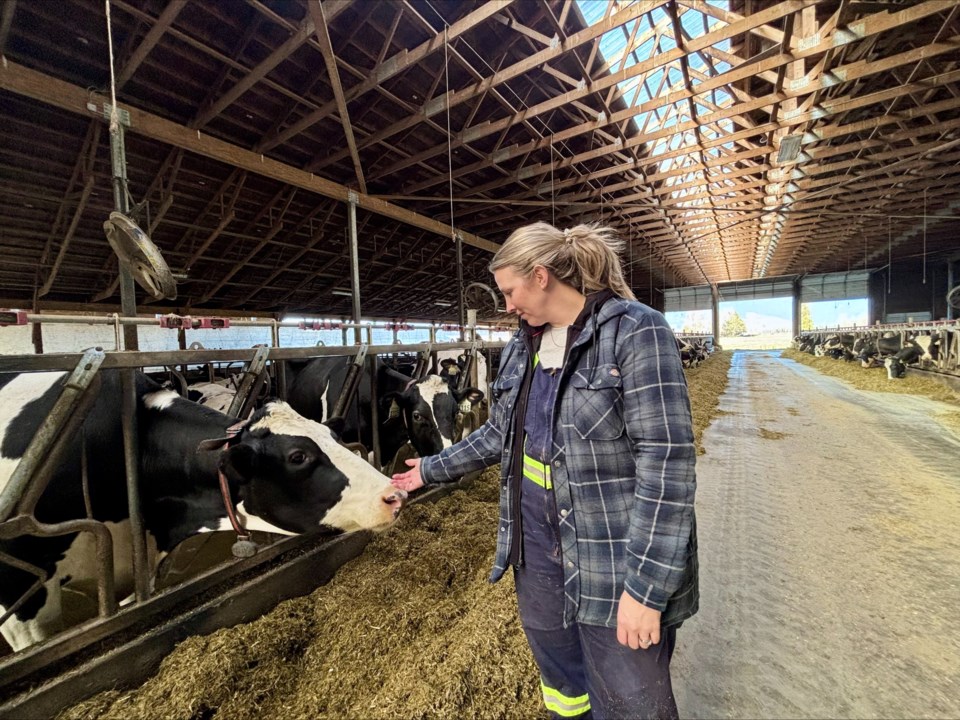Even with investors pumping money into artificial intelligence ventures, and widespread use and adoption of various AI tools across sectors, the technology’s application in agriculture remains in its infancy.
Entrepreneurs and farmers say they envisage AI products in their future, but many who spoke to BIV said they are not yet using it in their current operations.
B.C. companies are, however, starting to sell technologies that integrate AI into farming. Their corporate visions are big even if their corporate sizes are small.
The seven-employee, Surrey-based Cropvue, for example, has AI-related products to help farmers.
President Amy Jancewicz told BIV that her profitable, six-year-old company has dozens of customers, with most based in the U.S. Pacific Northwest.
She called her main product the Delta Trap. It includes a camera on top of a triangular trap that contains a sticky liner. Bugs get stuck on the liner, and after the camera takes daily photos, the AI can identify an insect’s species.
The traps also identify when different insect species start to get stuck on the trap in greater numbers.
Were farmers to have to manually go out to check the pest traps, they likely would not do so on a regular-enough basis to get advance warning of a pest invasion, Jancewicz explained.
“If you’re looking for a Codling moth, you want to know that you’re detecting a Codling moth,” Jancewicz said. “If you’re looking for an Oriental fruit moth, you want to know that that’s what you’re detecting.”
AI solves that problem as it can instantly determine which insects are which.
Cropvue technology also integrates data from local weather forecasts to enable farmers to predict when pests will arrive, she said. It can also recommend ideal times and intervals for spraying pesticide.
Underneath the triangular traps hang devices that measure temperature and humidity.
This is helpful because different parts of a field can have distinctive micro-climates, said Jancewicz.
The devices predict when frost will form, and give advance warnings so farmers can act, such as by starting frost fans or otherwise heating their land.
“We’re using standard mathematical procedures at this point to determine the weather, but we’re able to use the weather information along with the pest count to have AI predict when the flights of the pests are going to be,” she said.
Over at the Langley Regional Airport, sales manager Mia Gabrielson heads the Aeromni Aerospace subsidiary TurnTech, which is its drone division.
TurnTech’s drones can detect different light spectrums and detect crop photosynthesis.
“That’s hard to see just with an image,” she said. “A multi-spectral image just goes into a different level, outside of the normal range. It will tell you if your crop is healthy or if it is in distress.”
She said farmers can offload the data into software provided by drone maker DJI.
“They have an app where you can offload the imaging and manipulate it there,” she said.
TurnTech’s multi-spectral imaging can also be used in greenhouses to determine nitrogen levels, which is important to maintain plant health, Gabrielson added.
The drones can apply fertilizer, and AI helps farmers determine where to do that. Canada still forbids farmers from applying pesticides with drones.
“AI is a bit of a buzzword,” said Jim Shepard, who produces the Pacific Agriculture Show, which took place in late January and drew about 10,000 people to see around 300 exhibitors.
“I think excitement is really around Ag-tech, with AI being in that bucket.”
Dairy farming widely automated
AI builds on automation that is already widespread in farming.
Take dairy farming, for example.
Rosedale-based West River Farm principal Sarah Sache described to BIV how her farm has been at the forefront of using various technologies when it milks about 155 of its 335 cows.
Cows are enticed to walk into one of three specialized stalls by providing grain as a treat.
The stall is on a scale so Sache can get a cow’s weight. A robotic arm swings underneath the cow and lasers help it to identify where to place suction cups for milking.
Collars on the cows operate much like Apple watches, as they pick up even slight movements.
Each time a cow chews grass or corn, it is monitored, Sache told BIV.
“We can use that data to identify health trends,” she said.
Once milking is complete, a door automatically swings open for the cow to exit the stall. Sache can collect data on how long the milking process took and how much milk was collected.
“If the cow is a really slow milker, then you might not want to have her genetics promoted in the herd because it takes longer to get the same amount of milk,” Sache said.
Collars also track milking frequency to ensure that cows do not try to enter the stalls to get treats too often, and therefore get milked too often.
The problem is that despite Sache essentially swimming in data, she does not yet know of AI technology that can interpret and connect her multiple sets of data to provide insights on how to run her farm more efficiently, she said.
If she could analyze data better, she could understand how feeding regimens of corn or grass could impact how much fat or protein is in a cow’s milk, or in how certain feeding routines impact how much milk a cow can provide, she said.
“We have a lot of separate data sets, but they don’t interweave,” she said. “We have no way of looking at how all those separate data sets are correlated.”
About the only way she now uses AI is to help her think of similar names for her cows, she said with a laugh.
Other farmers, such as Driediger Farms principal Rhonda Driediger and W&A Farms principal Bill Zylmans told BIV that they too are interested in how AI can help their operations. So far, however, they have yet to integrate AI into their farming practices, they said.
“For a lot of the younger farmers, way younger than I am, this is completely up their alley,” said Zylmans, who is 67 years old.
“Our industry is definitely going to go down that technological road but for financial reasons, or others, it can be a challenge right now.”






